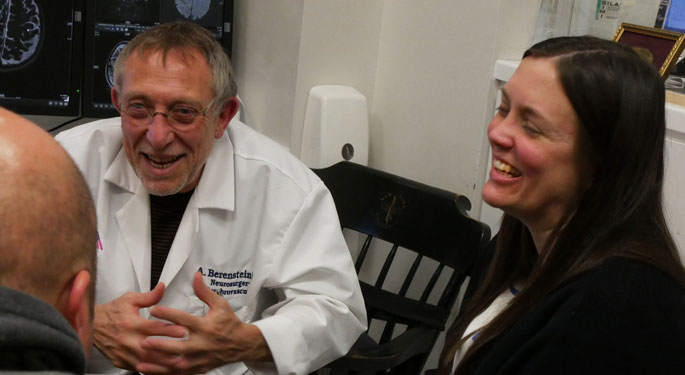
Venous Malformations
Venous malformations (VMs) are a type of type of vascular malformation that results from veins that have developed abnormally, which stretch or enlarge over time. VMs can be extremely painful and sensitive.
A VM usually looks like a bluish discoloration. It can be a single lesion or it may be one of many. It can be confined to one specific area or spread out; and it can be superficial or deep. The walls of a vein that has a VM lack the smooth muscle cells of a normal vein. VMs tend to get bigger if you cry, push, or otherwise increase pressure on your venous system. If the VM is superficial, it will be discolored blue and may appear in different areas of your body (called multifocal), especially around the mouth, lips, tongue, cheek, side of the face, scalp, and neck. Superficial VMs can range in size from tiny dots to large disfigurations.
VMs are soft. Usually, they dent if you press on them and get smaller when you raise the affected area, such as lifting your arm over your head. The blood in a VM circulates very slowly, causing blood clots to form and calcify, which creates "phleboliths" or vein stones. When VMs fill with blood, and the blood remains in the abnormal veins, it causes swelling. The swelling gets worse when the affected area is lower than the rest of the body (dependency) or when the pressure in the veins rises (such as when you hold your breath). They can expand due to age, injury, puberty, or pregnancy, and they can develop blood clots that may make it difficult for blood to reach the area around the VM. VMs rarely cause any strain on the heart.
Symptoms vary according to the location of the VM. Those involving the tongue or other structures around the airway may cause problems with breathing or speaking, while those in the arms and legs typically lead to painful swelling. Rarely, blood clots that form in a VM can travel to the lungs, creating a pulmonary embolism. An extremely large VM can consume blood clotting proteins, which makes the body unable to form blood clots (called localized intravascular coagulation).
Several diseases and conditions involve various types of VMs.
- Glomovenous malformations contain nerve cells and cause the malformations to become hardened and tense. These types of malformations can be inherited and often occur in multiple places.
- Blue rubber bleb nevus syndrome involves numerous rubbery lesions that can appear both externally and internally.
- Lesions in the stomach or gastrointestinal tract can cause severe abdominal pain and bleeding; we remove these surgically.
- Maffucci's syndrome can lead to VMs and bony growths called enchondromas. These can result in serious deformities that may worsen with age and become malignant.
Diagnosis
We can diagnose a VM in the skin and superficial tissue by physical examination. Magnetic resonance imaging (MRI) is the best imaging test to diagnose a VM, and to determine the extent of the condition. Ultrasonography is also useful when the VM is near the surface.
Although we do not understand the exact cause of VMs, testing suggests that there are several genetic mutations involved.
Treatment Options
A VM that is not causing symptoms does not require treatment. Basic treatment consists of the use of graded elastic compression stockings or sleeves (for a VM of the leg or arm) to prevent swelling and low-dose aspirin to minimize the formation of painful blood clots.
When these measures are not adequate, we close or remove the enlarged venous spaces, using one of several techniques:
- Sclerotherapy happens in an angiography suite (an operating room containing specialized X-ray and ultrasound equipment), usually under general anesthesia. We place a needle into the VM, inject contrast medium to outline the VM on an X-ray, and then introduce a sclerosant into the abnormal veins. The sclerosant causes the veins to shrink gradually; we usually need to perform this procedure several times to achieve complete and permanent shrinkage.
- Endovenous laser therapy is similar to sclerotherapy, but involves placing a diode laser fiber through a needle or catheter. It is useful for treating large venous channels or spaces and is often combined with sclerotherapy. The combination of endovenous laser therapy and sclerosant injection appears to produce a quicker response and an easier recovery.
- Venous embolization includes placing permanent devices, such as coils or embolization glue, through a catheter into the VM to seal off the spot where the VM connects to the circulating veins. We often perform this technique in combination with sclerotherapy or surgery.
- Surgical excision involves removing the abnormal veins and the tissue around them. We use this approach most often with facial VM, to restore a more normal facial contour. Usually, we perform surgery after sclerotherapy, which helps to reduce bleeding and makes it easier to remove the VM.
We believe VMS are caused by a genetic abnormality in the affected tissue. Therefore, except for small lesions, VMs are not curable; no matter how we treat them, they usually recur. Extensive VMs often require a series of ablation procedures, and then additional treatment a few years later. It is important to remember, though, that treatment is helpful in the long term to control the growth and the symptoms.